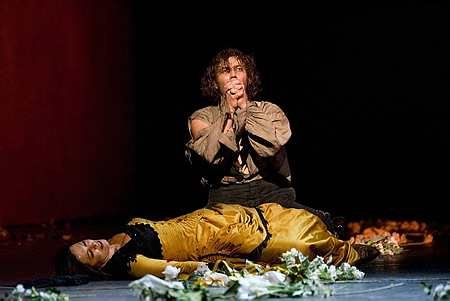|
|
|
|
|
|
|
|
| Mundoclasico.com |
| Enrique Sacau |
Bizét: Carmen, Royal Opera House, London, December 2006
|
Postcard from Andalusia
|
|
 A fountain, a hen, two donkeys, a horse, lots of
toreros and the virgin of Macarena made it into Francesca Zambello’s new
production of Georges Bizet’s operatic blockbuster par excellence. Once
again, Carmen was the perfect excuse for a glamorous night at the opera
filled with pseudo-Spanish apparel, beautiful jewellery and fashionable
dresses. This display of brilliance seemed to annoy some highbrow critics
who talked bitterly about the “frivolity” of the evening. “So what?”, I
thought. If the event was not enjoyable for them it should not be because of
the outfits of the very generous sponsors present at the House, nor because
of Zambello’s extensive stereotypical Spanish references. Indeed, Carmen is
a waypoint in the construction of Spanish nationalist music. Actually,
Spanish musical nationalism was modelled on Carmen (amongst other pieces) in
the composers’ search for a distinctive Spanish musical flavour and not the
other way round. A production of Carmen which is a mere postcard of
Andalusia, therefore, seems to me to be perfectly valid and well suited to
its genre, opéra comique. A fountain, a hen, two donkeys, a horse, lots of
toreros and the virgin of Macarena made it into Francesca Zambello’s new
production of Georges Bizet’s operatic blockbuster par excellence. Once
again, Carmen was the perfect excuse for a glamorous night at the opera
filled with pseudo-Spanish apparel, beautiful jewellery and fashionable
dresses. This display of brilliance seemed to annoy some highbrow critics
who talked bitterly about the “frivolity” of the evening. “So what?”, I
thought. If the event was not enjoyable for them it should not be because of
the outfits of the very generous sponsors present at the House, nor because
of Zambello’s extensive stereotypical Spanish references. Indeed, Carmen is
a waypoint in the construction of Spanish nationalist music. Actually,
Spanish musical nationalism was modelled on Carmen (amongst other pieces) in
the composers’ search for a distinctive Spanish musical flavour and not the
other way round. A production of Carmen which is a mere postcard of
Andalusia, therefore, seems to me to be perfectly valid and well suited to
its genre, opéra comique.
Zambello’s production of Carmen itself needs work, but not the sets
(designed by Tanya McCallin and remarkably similar to the ones used for
their Don Giovanni). It needs work because the main characters floated
around the stage directionlessly. Carmen, for example, could not keep her
knees together, but Zambello’s direction did not push her further than this.
Not a single movement or gesture revealed any striking aspect of her
character; the same applies to Don José and Escamillo. At the end, the
complex relationships of the opera passed unnoticed and we were not told
anything interesting. Zambello worked well with the crowds, though, and
moved the choir, the flamenco dancers and the children adequately: they did
not bump into each other on an utterly overcrowded stage which does nothing
for her image of a director who seems to suffer from scenic agoraphobia.
Musically, things were more remarkable. To begin with, Anna Caterina
Antonacci’s Carmen debut was rewarded by the audience with a well-deserved
ovation. This could have been even better had she matched the standard of
her excellent renditions of “L’Havanaise” and the “Seguedilles”. Her “Les
tringles des sistres”, scene of the cards and final duet revealed a tired
singer. Her acting was as outstanding as ever, but her singing was less
brilliant as the opera went on. Jonas Kaufmann, on the other hand, warmed
to the task as the opera proceeded: he sang the “air of the flower”
beautifully, although he sounded rather emasculated (especially as his final
B was raspy). From then on, however, he sounded virile and thrilling,
especially in the final duet. This might be the reason why Kaufmann (also
debuting his part) got a better ovation from the audience. Ildebrando
D’Arcangelo’s Escamillo was underpowered, but his acting made up for it (as
often happens). Norah Amsellem’s Micaëla was as affected as her role
requires and not particularly enthralling.
The artist who towered above all was Antonio Pappano (again, as usual). His
light tempi and the magnificent sound he extracted from the Royal Opera
Orchestra, as well as his ability to accompany the singers efficiently, made
him one of the three great successes of the evening, paired with the
protagonist duo. One can get used (and one is indeed used now) to Pappano’s
glorious renditions of almost everything he conducts. His close collaborator
Renato Balsadonna, who has made the Royal Opera Chorus sound lighter and
brighter than ever, must also take the credit for the excitement of yet
another very satisfying night at the Royal Opera House.
A final thought: it must be added that this postcard from Andalusia exposes
the fact that many women died, and still die today. They are victims of the
cowardice and complexes of their despicable partners. |
|
|
|
|
|
|
|
|
|
|
|
|
|
|
|
|
|
|